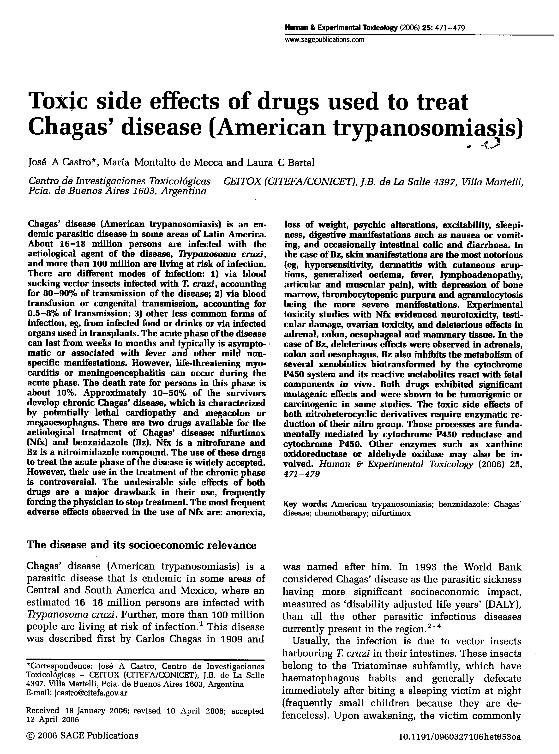Mostrar el registro sencillo del ítem
dc.contributor.author
Castro, Jose Alberto

dc.contributor.author
Montalto, Maria

dc.contributor.author
Bartel, Laura Cecilia

dc.date.available
2019-09-03T18:06:58Z
dc.date.issued
2006-08
dc.identifier.citation
Castro, Jose Alberto; Montalto, Maria; Bartel, Laura Cecilia; Toxic side effects of drugs used to treat Chagas disease (American Trypanosomiasis); Sage Publications Ltd; Human and Experimental Toxicoloxy; 25; 8; 8-2006; 471-479
dc.identifier.issn
0960-3271
dc.identifier.uri
http://hdl.handle.net/11336/82805
dc.description.abstract
Chagas' disease (American trypanosomiasis) is an endemic parasitic disease in some areas of Latin America. About 16-18 million persons are infected with the aetiological agent of the disease, Trypanosoma cruzi, and more than 100 million are living at risk of infection. There are different modes of infection: 1) via blood sucking vector insects infected with T. cruzi, accounting for 80-90% of transmission of the disease; 2) via blood transfusion or congenital transmission, accounting for 0.5-8% of transmission; 3) other less common forms of infection, eg, from infected food or drinks or via infected organs used in transplants. The acute phase of the disease can last from weeks to months and typically is asymptomatic or associated with fever and other mild non-specific manifestations. However, life-threatening myocarditis or meningoencephalitis can occur during the acute phase. The death rate for persons in this phase is about 10%. Approximately 10-50% of the survivors develop chronic Chagas' disease, which is characterized by potentially lethal cardiopathy and megacolon or megaoesophagus. There are two drugs available for the aetiological treatment of Chagas' disease: nifurtimox (Nfx) and benznidazole (Bz). Nfx is a nitrofurane and Bz is a nitroimidazole compound. The use of these drugs to treat the acute phase of the disease is widely accepted. However, their use in the treatment of the chronic phase is controversial. The undesirable side effects of both drugs are a major drawback in their use, frequently forcing the physician to stop treatment. The most frequent adverse effects observed in the use of Nfx are: anorexia, loss of weight, psychic alterations, excitability, sleepiness, digestive manifestations such as nausea or vomiting, and occasionally intestinal colic and diarrhoea. In the case of Bz, skin manifestations are the most notorious (eg, hypersensitivity, dermatitis with cutaneous eruptions, generalized oedema, fever, lymphoadenopathy, articular and muscular pain), with depression of bone marrow, thrombocytopenic purpura and agranulocytosis being the more severe manifestations. Experimental toxicity studies with Nfx evidenced neurotoxicity, testicular damage, ovarian toxicity, and deleterious effects in adrenal, colon, oesophageal and mammary tissue. In the case of Bz, deleterious effects were observed in adrenals, colon and oesophagus. Bz also inhibits the metabolism of several xenobiotics biotransformed by the cytochrome P450 system and its reactive metabolites react with fetal components in vivo. Both drugs exhibited significant mutagenic effects and were shown to be tumorigenic or carcinogenic in some studies. The toxic side effects of both nitroheterocyclic derivatives require enzymatic reduction of their nitro group. Those processes are fundamentally mediated by cytochrome P450 reductase and cytochrome P450. Other enzymes such as xanthine oxidoreductase or aldehyde oxidase may also be involved.
dc.format
application/pdf
dc.language.iso
eng
dc.publisher
Sage Publications Ltd

dc.rights
info:eu-repo/semantics/openAccess
dc.rights.uri
https://creativecommons.org/licenses/by-nc-sa/2.5/ar/
dc.subject
American Trypanosomiasis
dc.subject
Benznidazole
dc.subject
Chagas' Disease
dc.subject
Chemotherapy
dc.subject
Nifurtimox
dc.subject.classification
Toxicología

dc.subject.classification
Medicina Básica

dc.subject.classification
CIENCIAS MÉDICAS Y DE LA SALUD

dc.title
Toxic side effects of drugs used to treat Chagas disease (American Trypanosomiasis)
dc.type
info:eu-repo/semantics/article
dc.type
info:ar-repo/semantics/artículo
dc.type
info:eu-repo/semantics/publishedVersion
dc.date.updated
2019-08-26T18:14:15Z
dc.journal.volume
25
dc.journal.number
8
dc.journal.pagination
471-479
dc.journal.pais
Reino Unido

dc.journal.ciudad
Londres
dc.description.fil
Fil: Castro, Jose Alberto. Consejo Nacional de Investigaciones Científicas y Técnicas. GP. CITEFA - Centro de Investigaciones Toxicológicas (I); Argentina
dc.description.fil
Fil: Montalto, Maria. Consejo Nacional de Investigaciones Científicas y Técnicas. GP. CITEFA - Centro de Investigaciones Toxicológicas (I); Argentina
dc.description.fil
Fil: Bartel, Laura Cecilia. Consejo Nacional de Investigaciones Científicas y Técnicas. GP. CITEFA - Centro de Investigaciones Toxicológicas (I); Argentina
dc.journal.title
Human and Experimental Toxicoloxy

dc.relation.alternativeid
info:eu-repo/semantics/altIdentifier/url/https://journals.sagepub.com/doi/10.1191/0960327106het653oa
dc.relation.alternativeid
info:eu-repo/semantics/altIdentifier/doi/https://doi.org/10.1191/0960327106het653oa
Archivos asociados
